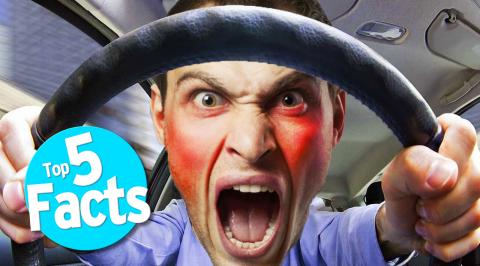Top 5 Road Rage Facts

On the road, safety always comes first. Well, except when ego comes into play. Welcome to WatchMojo's Top 5 Facts. In this instalment, we're taking a look at the most interesting facts about Road Rage. Almost all of the research we found on the topic dealt with road rage in North America, and especially in the US, so that's mostly what these facts focus on.
Special thanks to our user christo for submitting the idea using our interactive suggestion tool at http://www.WatchMojo.comsuggest
#5: The Term “Road Rage” Emerged in Late 80s Los Angeles
Life in “the big city” has long been connected to heavy traffic and personal meltdowns. And few cities, if any, have traffic that rivals that of Los Angeles. The frustration of all that smoggy gridlock led to a series of shootings on LA freeways that inspired the term “road rage.” The L.A. Times published an article in July of, 1987 that detailed the increased violence over a six-week stretch, in which 16 highway shootings were documented in Southern California. No arrests were reported in 12 of the incidents, and so, the motivations remained unclear. As a result, the media called such behavior “road rage.” Reporters from local TV station KTLA first began using the phrase and it caught on like wildfire– which, incidentally, is another frequent problem in LA.
#4: Reckless Driving, Aggressive Driving and Road Rage Can All Look the Same
So you see someone swerve out of their lane, and then cut someone off. It looked reckless, and aggressive, but was it road rage? How can you tell? The fine line between “aggressive driving” and “road rage” is a problem researchers have had to deal with. A multiyear study by Texas A&M argued that any technical use for either term is problematic because individual drivers perceive the two acts in different ways. However, if road rage is over-reported, we are more likely to identify plain old bad driving as an act of directed aggression. The study therefore notes that “part of the ‘cure’ for road rage is that the public's perspective of the problem is restored to realistic proportions.” In other words, while it’s hard to misinterpret someone flipping you the bird, don’t make assumptions about intention when the situation isn’t quite so clear.
#3: Instagram Posts Show #RoadRage Happens Exactly When You’d Expect
In 2016, the website AutoInsuranceCenter.com analyzed 65,000 Instagram posts for some insight. Granted, this is more a reflection of when people are posting about road rage, than an actual measure of when we’re road ragiest. Unsurprisingly, that time is Friday at 6 PM. Makes sense– working people are at their most fatigued and it’s rush hour. Plus, many are desperately trying to get out of town for a little R & R. In fact, July and August, when folks are typically taking vacations in North America, are the most #roadrage-filled. And, shockingly, LA is the national road rage capital. What other great insights were there? Did people swear a lot when talking about– oh, yup, they did. I think what this Instagram study is actually demonstrating are two of the things that social media is best at: confirming our biases and pointing out the blatantly obvious.
#2: 80% of Drivers Act Out Their Anger
You’re probably sitting there thinking “pff! Not me!” But be honest. In 2016, the AAA Foundation for Traffic Safety released the results of a survey of 2,705 American drivers. 80% of respondents admitted to having expressed significant anger, aggression, or road rage at least once while driving in the past year. They also found that 51% of people have purposefully tailgated, and 3% bumped or rammed another vehicle on purpose. Am I the only one who finds that number really high? Some other common characteristics of angry drivers: they are much more likely to habitually run red lights and speed, and other studies have found links between aggressive driving and impulsive, angry personalities, and even a history of concussions.
#1: Road Rage Is Deadly
Yeah, this might be kinda obvious as a fact, but it deserves to be said again. Road rage leads to violence, and violence often leads to death. A 2015 report by NHTSA noted a yearly increase of fatal accidents involving both aggressive driving and road rage. The NHTSA also reports that 66% of deaths on the road are a result of aggressive driving. The AAA Foundation for Traffic Safety says 37% of aggressive driving conflicts involve at least one firearm. So, what to do? Experts say just don’t engage; avoid making eye contact with an automotive aggressor, and resist the urge to respond the jerk in kind. And, oh yeah, don’t be that jerk.
So, what fact surprises you the most? And how do you calm yourself on the road? For more intellectual top 10s and raging Top 5s, be sure to subscribe to WatchMojo.com.
